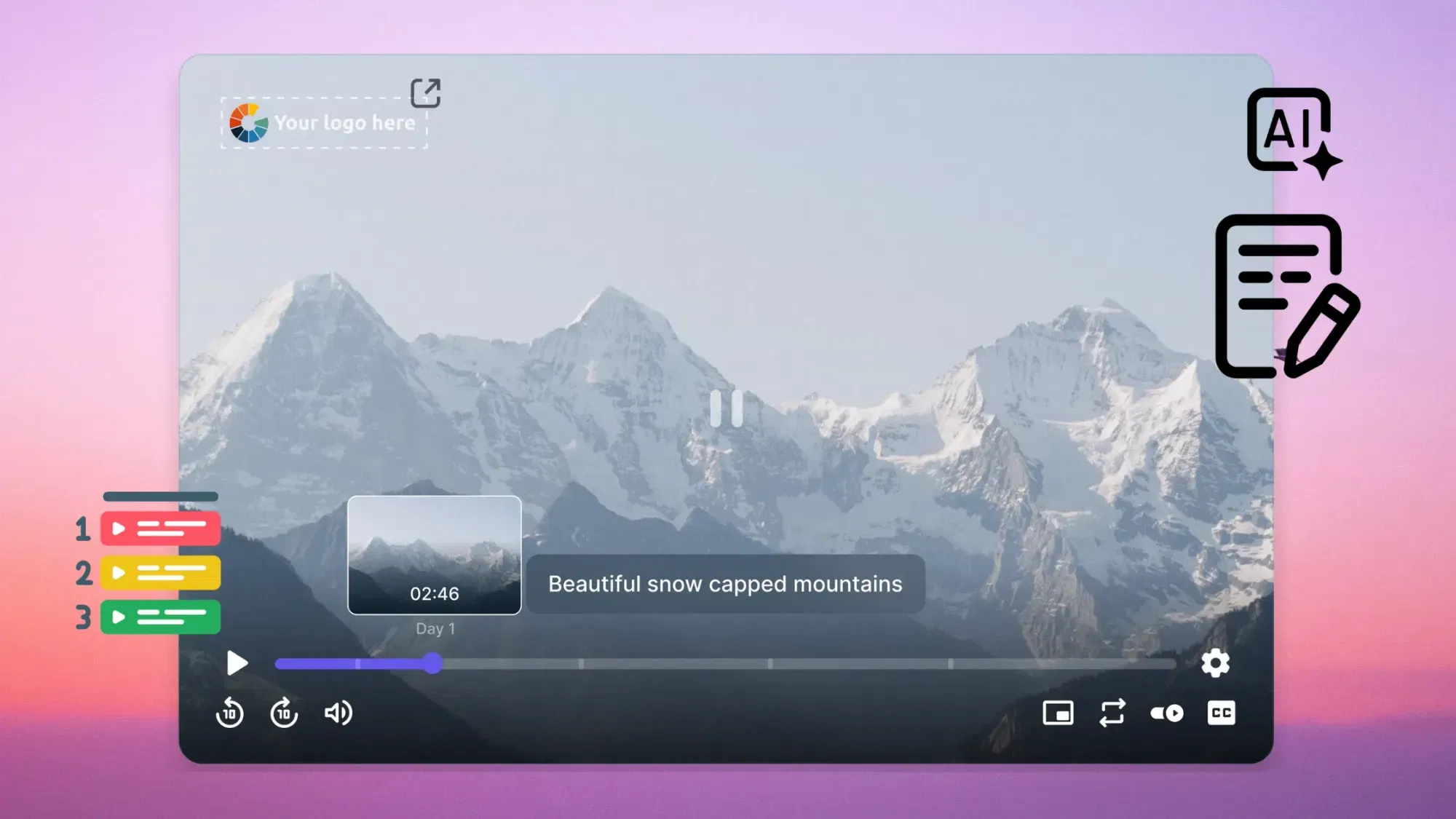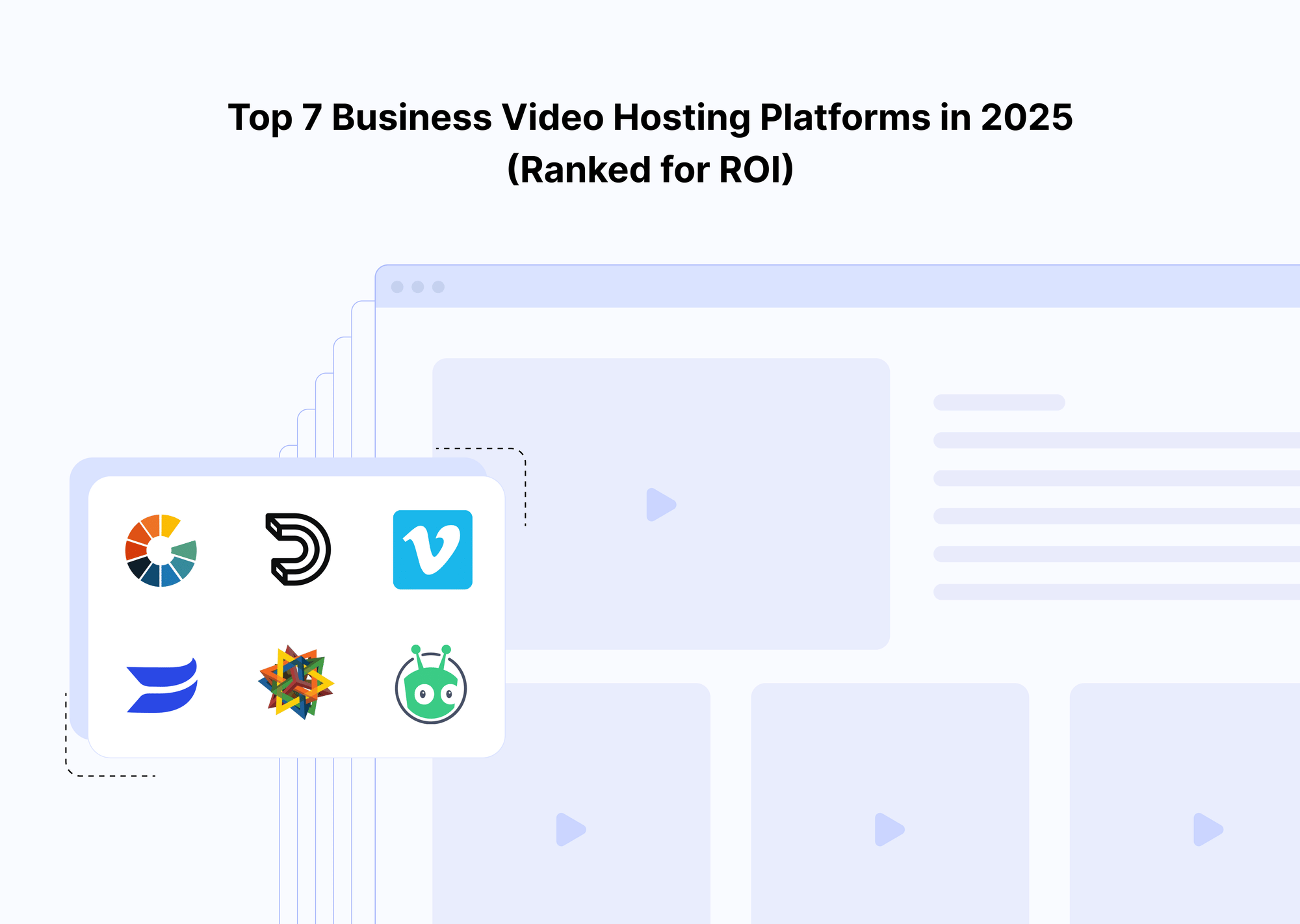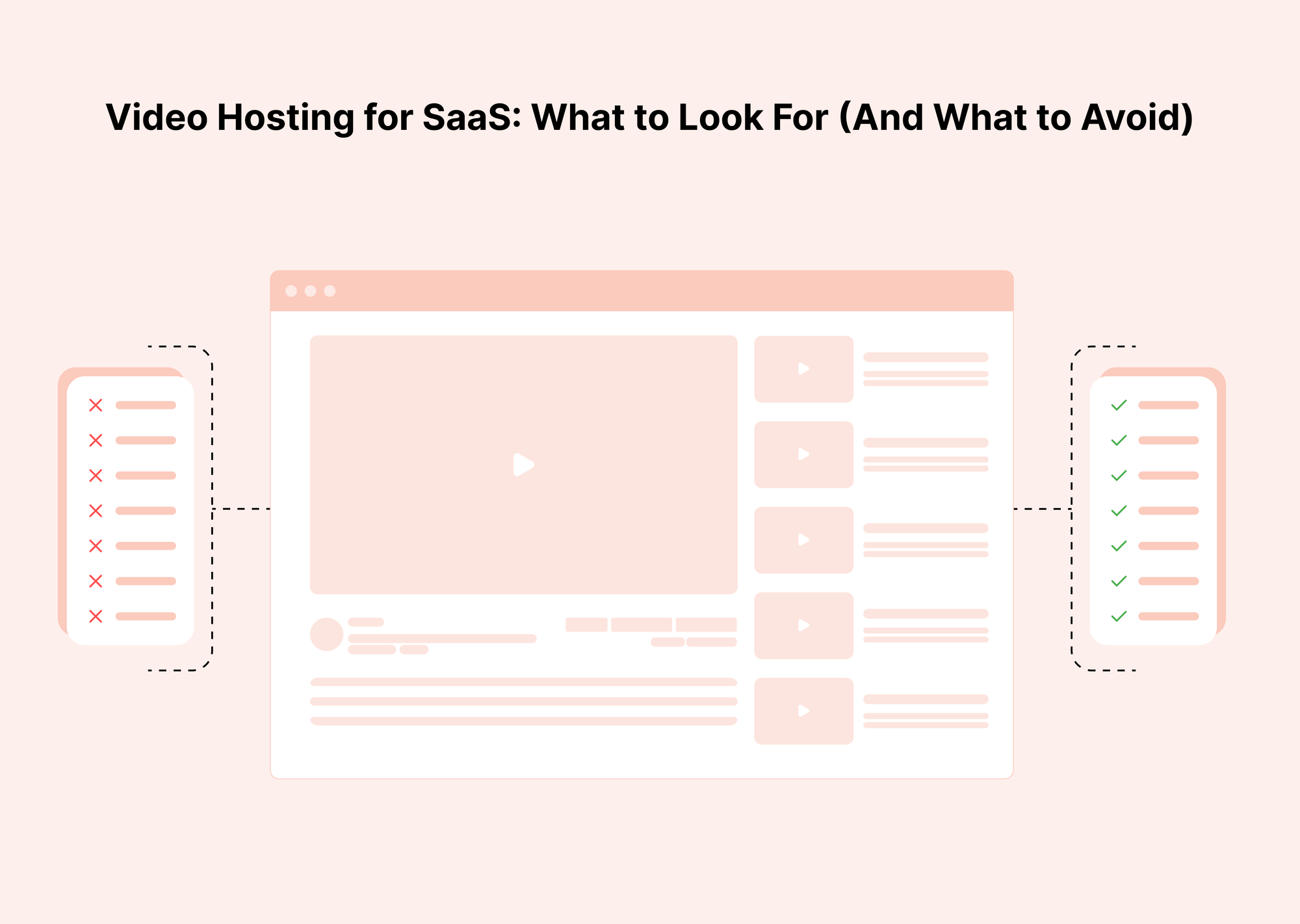In 2025, video is foundational for business ROI and success. From marketing campaigns to internal training, embed-everywhere video is now expected. But not all video hosting is created equal. Choosing the platform that maximizes return on investment (ROI) means balancing cost, security, analytics, brand control, and user experience.
Why Video Hosting Matters for ROI in 2025
When it comes to video hosting for business, ROI is determined by more than just views. It’s about converting attention into leads, sales, brand lift, or internal efficiency — while minimizing waste and risk.
Here are the key pillars driving ROI:
- Security & Control: As businesses share more proprietary or customer-facing video content, having control over who sees it, when, where, and how becomes critical. Unauthorized embedding, data leaks, or content scraping can erode trust and cost money. A platform offering DRM, tokenized access, embedding restrictions, SSO/SSO, IP/geo blocking, or encryption can dramatically reduce leakage or misuse.
- Branding & User Experience: A plain YouTube frame with logos and “Related Videos” distracts viewers. For high-stakes content (sales demos, training, product launches), you want white-label, customizable players, CTA overlays, in-player interactivity, and seamless embed styling. That supports brand consistency and higher conversion rates.
- Analytics & Conversion Intelligence: The ability to see not only plays, but heatmaps, engagement drop-offs, cohort behavior, conversion paths, A/B testing, and viewer segmentation empowers you to refine messaging. If a platform lacks granular analytics, you're flying blind.
- Scalability, Performance & Delivery Cost: Having a robust CDN, adaptive bitrate streaming, transcoding, multi-region delivery, and efficient bandwidth usage ensures smooth playback globally. Poor video experience (buffering, low resolution) kills conversions. Also, overages or inefficient pricing for bandwidth/storage can erode ROI.
- Support, Ecosystem & Integrations: Integration with your marketing stack (CRM, email tools, LMS), automation, APIs, webhooks, and support responsiveness all influence how “frictionless” your video workflows are. Friction eats ROI.
To put things in perspective, the data from 2025 makes a compelling case for why video has become central to business ROI. According to a recent SundaySky report, 93% of marketers now believe that video delivers strong returns on investment - the highest consensus yet recorded. Meanwhile, 85% of marketers plan to increase their video spending this year, reflecting growing confidence in the medium’s measurable impact.
From a performance standpoint, businesses that incorporate video on their websites see an average conversion rate of 4.8%, compared to just 2.9% for those without it, while click-through rates improve by nearly 65%. The medium’s dominance is equally evident in scale: by 2025, video will account for roughly 82% of all internet traffic, according to The Desire Company, and 89% of businesses already use video as a key marketing tool (Wyzowl).
Taken together, these numbers show that video is no longer a creative accessory. It’s a strategic engine for engagement, performance, and revenue growth. But realizing that potential depends on one crucial choice: selecting the right business video hosting platform to support security, scalability, and long-term ROI.
Top 7 Business Video Hosting Platforms in 2025 (Ranked for ROI)
Below is a curated list of video hosting platforms optimized for business use, ranked by their potential ROI tradeoffs. Each has unique strengths and tradeoffs, so you must choose based on your use case.
1. Gumlet – Best for Small Businesses, Enterprises & Creative Teams
Gumlet is primarily known for video optimization and delivery. Still, in 2025 it’s increasingly used as a lightweight hosting + streaming solution — especially for teams that value performance, cost control, and seamless integration.
Key Features
- Adaptive video optimization (automated compression, resolution switching)
- Global CDN distribution & caching
- Analytics/viewer metrics
- API / SDK access
- Pay-as-you-go or usage-based pricing
Pros
- You pay for exactly what you use, making it cost-efficient as usage scales
- Excellent performance through optimization + CDN
- Flexible integration through APIs — works well as a backend video layer
- Offers a free plan/trial to get started
Cons
- Doesn’t always offer a complete “out-of-the-box” marketing UI (less mature overlays, lead capture, etc.)
- You may need to compose it with other tools (player, lead-form, front-end logic)
- Fewer built-in interactive tools compared to full-featured online video platforms
Pricing: According to Gumlet’s official pricing, they use a per-minute / usage model. They offer a free plan and provide a 14-day trial for paid tiers. Gumlet advertises multiple plan tiers:\
- Free: $0, includes 100 storage minutes, 250 GB bandwidth/month, 250 live streaming minutes, customizable video player, privacy controls.
- Creator: $10/month, includes 4,000 storage minutes, unlimited streaming, 1,200 live stream minutes, GDMA blocking, CTAs, analytics.
- Professional: $24/month, includes 10,000 storage minutes, unlimited streaming, 4,000 live minutes, role-based access, signed URLs, AI transcripts
- Business: $120/month, includes 15,000 storage minutes, 2.5 TB streaming, 10,000 live minutes, API/SDK access, DRM (Widevine & FairPlay), dynamic watermarking.
- Enterprise: custom pricing, with unlimited storage, custom bandwidth, unlimited live streaming, advanced integrations, dedicated support
Best For: Small-to-midsize businesses or creative teams who want strong video delivery + performance, and who are comfortable building front-facing layers around the hosting backend.

2. Wistia – Best for Marketing & Branding ROI
Wistia is often the marketer’s favorite — it emphasizes conversion tools, branding control, analytics, and lead capture.
Key Features
- White-label, customizable video player
- In-player CTAs, lead capture, and email gating
- Viewer heatmaps, drop-off analytics, segmentation
- Integration with marketing stacks (CRMs, email tools)
- Video SEO support, sitemaps, and embed customization
Pros
- Very marketer-centric: built from the ground up for lead generation and branding
- Strong analytics and tools for optimizing video performance
- Reliable, polished platform
- A free tier for small-scale experimentation
Cons
- Pricing can become steep as you scale
- Less emphasis on enterprise-level streaming / live / security features
- Live or internal video functionality is more limited compared to specialized platforms
Pricing
According to Wistia’s official pricing page, the tiers are: Free — $0, Starter — $10/month (billed annually), Pro — $80/month (billed annually), and Advanced — $370/month (billed annually). A Premium option is also shown below these tiers with custom pricing. The page notes that no credit card is required and offers a free trial for paid plans.
Best For: Marketing teams, content-driven businesses, or brand-first organizations that want video to drive conversions and want deep visibility and control over the viewer journey.
3. Brightcove – Best for Enterprise-Grade Security
Brightcove has long been a staple for enterprise video needs. It offers scale, security, reliability, and advanced features designed for large organizations.
Key Features
- Enterprise-level security (DRM, tokenization, SSO, secure delivery)
- Multi-CDN and global scale
- Analytics, reporting, A/B video testing
- Unified live + VOD capabilities
- Support for TV/OTT, monetization, apps
- Rich APIs and customization frameworks
Pros
- Very robust and mature; built for large volume, high security environments
- Excellent reliability, uptime, and global reach
- Extensive support, SLAs, and technical backing
- Ideal for media, global brands, and broadcasters
Cons
- Cost tends to be high and less transparent — often negotiated contract
- Overkill for small or mid-tier video usage
- Some advanced modules/features may require additional licensing
Pricing: Brightcove does not publish fixed standard pricing tiers; instead, pricing is custom and negotiated directly with each client. They tailor contracts based on usage, scale, modules required, support levels, and additional features.
Best For: Large enterprises, media companies, brands with global reach or strict compliance and security requirements.
4. SproutVideo – Best for Privacy & Internal Business Use
SproutVideo is built with privacy, internal use, and secure video distribution in mind. If your priority is controlling who sees your video (e.g., internal training, HR, private content), it’s a strong contender.
Key Features
- Password protection, domain restrictions, private links
- SSL encryption, access control, and viewer login
- Embed controls, playlisting, and domain-level restrictions
- Analytics, APIs
- Live streaming support (on higher tiers)
Pros
- Great mix of usability + security for internal or private video use
- More budget-friendly than many enterprise platforms
- Transparent tiering of features
- Free trial available
Cons
- Less emphasis on advanced marketing overlays, CTAs, and lead capture
- Live streaming is one of the, if not as powerful or flexible as, specialized live platforms
- At a vast scale, one might run into performance or cost constraints
Pricing
According to SproutVideo’s official pricing page, the platform offers four paid tiers along with a 30-day free trial that includes full feature access. The Seed plan is priced at $10 per month, the Sprout plan at $35 per month, the Tree plan at $75 per month, and the Forest plan at $295 per month. Each tier scales based on storage, bandwidth, live streaming capacity, and access control features to suit businesses of different sizes and video needs.
Best For: Internal communications, HR training, private video libraries, and any scenario where controlled access and privacy are prioritized over mass marketing features.
5. Vidyard – Best for Sales & Lead Generation
Vidyard is built around using video as a sales and outreach tool. It’s especially popular for outbound, personalized video, tracking, and embedding inside sales workflows.
Key Features
- Personalized video creation for outreach
- Embedding video in emails + tracking
- CRM / marketing integration (Salesforce, HubSpot, etc.)
- CTAs, overlays, forms inside video
- Analytics tied to accounts/leads
- Video hosting + hubs/portals
Pros
- Excellent ROI for sales and marketing teams
- Deep CRM and workflow integration
- Good balance of hosting + engagement features
- Scalable, cloud-based infrastructure
Cons
- Costs per user/seat; can add up
- Not always ideal for very high-volume broadcasting or pure streaming use
- Some advanced analytics or features are locked to premium tiers
Pricing
Vidyard’s public pricing includes a Free option, a mid-tier Starter plan (e.g., $59/user/month when billed annually), and higher Teams/Enterprise tiers available via custom quotes. Optional add-ons (e.g., the “Video Agent” tool) are priced per seat and may be included in higher tiers. The features and limits expand with each premium tier.
Best For: Sales teams, SDRs, customer-facing roles, embedding video in email / CRM workflows, personalized demo outreach, and tracking video-driven conversions.
6. Dacast – Best for Live Business Streaming
When your use case involves live broadcasting (webinars, virtual events, product launches) alongside VOD, Dacast is one of the strongest unified platforms combining streaming, security, and monetization.
Key Features
- Unified live + VOD hosting
- Security options: tokenization, password/domain restrictions, signed URLs
- White-label embedding, ad-free playback
- Multi-bitrate, DVR, real-time recording
- Monetization (paywalls, subscriptions)
- Analytics, API, global CDN delivery
Pros
- Excellent for live or hybrid event workflows
- Solid security and embed control
- Scalable and reliable infrastructure
- Transparent pricing model
Cons
- As usage grows, costs can escalate
- For pure VOD use cases, some live-centric features may be overkill
- Some learning curve for the full event toolkit
Pricing
Dacast’s official pricing is tiered and transparent. They list plans like Starter at $39/month (including specified bandwidth and storage), Event at $63/month, Scale at $165/month, with additional higher / custom options. They also offer a 14-day free trial with starter bandwidth to test out their platform.
Best For: Organizations that host webinars, live events, product launches, or hybrid broadcast + on-demand workflows, and want security + monetization built in.
7. Kaltura – Best Open-Source & Customizable Hosting
Kaltura is a flexible, modular solution favored by educational institutions, media organizations, and enterprises needing deep customization or self-hosting options.
Key Features
- Open-source core or cloud deployment
- Full video CMS, publishing, plugin architecture
- Rich APIs, plugin & extension ecosystem
- Support for live + VOD, monetization, LMS integration
- Custom workflows, modular architecture
Pros
- Maximum flexibility and control — you can tailor almost everything
- No vendor lock-in if self-hosting
- Scalable across internal + external usage
- Strong in verticals like education, media, large institutions
Cons
- More technical complexity — setup, maintenance, infrastructure overhead
- Self-hosting or customization incurs operational cost
- Public pricing is not transparent — many configurations are negotiated
Pricing: Kaltura offers a mixture of open-source licensing and cloud-hosted services. Its pricing is mostly custom, with modular licensing for video platform services, webinar solutions, virtual classrooms, and other modules.
Best For: Universities, media companies, and large enterprises wanting complete control over video workflows, custom integration, or mixing internal and public video services in one platform.
Comparison Table of Video Hosting Platforms (2025)
| Platform | Key Features / Differentiator | Pricing / Trial | Free Trial / Free Tier | Best Use Cases |
|---|---|---|---|---|
| Gumlet | Adaptive optimization, global CDN, APIs, analytics | Free ($0), Creator $10/mo, Professional $24/mo, Business $120/mo, Enterprise (custom) | Free plan + 14-day trial | Small to mid-size businesses and creative teams needing scalable, optimized video delivery |
| Wistia | Custom branding, CTAs, analytics, marketing integrations | Free ($0), Starter $10/mo, Pro $80/mo, Advanced $370/mo, Premium (custom) | Free plan + free trial on paid tiers | Marketing teams and brand-driven businesses focused on conversion and engagement |
| Brightcove | Enterprise-level security, global delivery, OTT support | Custom enterprise contracts based on usage and modules | Demo / Proof-of-Concept available | Large enterprises, media, and organizations with strict compliance and security needs |
| SproutVideo | Secure embeds, domain restrictions, analytics, internal hosting | Seed $10/mo, Sprout $35/mo, Tree $75/mo, Forest $295/mo | 30-day free trial with full features | Internal communications, HR training, and privacy-sensitive business content |
| Vidyard | Personalized sales videos, CRM integration, analytics | Free plan, Starter $59/user/mo (annual), Teams & Enterprise (custom) | Free plan + trial for paid plans | Sales and outreach teams using video for prospecting and CRM workflows |
| Dacast | Live + VOD hosting, paywalls, DRM, analytics | Starter $39/mo, Event $63/mo, Scale $165/mo, Custom enterprise options | 14-day free trial | Webinars, product launches, and large-scale business live streaming |
| Kaltura | Open-source and modular, APIs, LMS integration, monetization | Webinars from $150/mo; other modules and cloud deployments are custom-priced | Demo access and self-host (open-source) version available | Education, media, and enterprises needing full customization and integration flexibility |
Free vs. Paid Business Video Hosting: Which Should You Choose?
Choosing between free and paid business video hosting platforms depends on your goals, audience, and how critical video is to your operations. While free options can help you get started, businesses focused on ROI, brand control, and data security almost always find paid video hosting for business the more sustainable choice.
Pros and Cons of Free Video Hosting Platforms
Free video hosting platforms such as YouTube or Vimeo’s basic plan are appealing for startups and small teams because they require no upfront cost and provide instant visibility. They’re easy to set up, have familiar interfaces, and automatically handle bandwidth, compression, and global delivery. For publicly accessible content such as brand teasers or product demos, they can serve as useful launchpads.
However, the tradeoffs quickly become evident for professional use. Free platforms offer limited branding control — your videos are often surrounded by third-party ads, suggested content, or platform logos that distract viewers and dilute your brand identity. You also sacrifice control over access, as these platforms rarely support domain restrictions, encryption, or IP/geo-blocking. Moreover, analytics are basic, focusing on views and likes rather than on in-depth engagement metrics.
Free hosting also introduces risks for businesses. Content policies can change without notice, leading to demonetization or takedowns. Storage and feature limits restrict scalability, and there’s no guaranteed uptime or customer support. As a result, most companies eventually outgrow these platforms when they need secure video hosting for business and measurable ROI.
Why Businesses Switch to Paid Hosting for ROI, Control, and Security
Paid business video hosting platforms like Gumlet, Wistia, or Brightcove are designed for professional scalability and control. They replace the uncertainty of free tools with predictable performance and measurable business value.
From an ROI standpoint, paid video hosting directly impacts conversions. With features such as branded players, in-video CTAs, gated access, and analytics dashboards, you can turn engagement into leads and revenue. These platforms also provide advanced analytics — tracking heatmaps, drop-off points, viewer segmentation, and campaign performance — helping businesses refine strategy and improve ROI over time.
Brand consistency is another significant benefit. Paid video hosting for business lets you fully customize the player, remove third-party logos, and create a seamless visual experience aligned with your corporate identity. Combined with stronger privacy controls and access management, it ensures your videos stay professional, secure, and compliant with internal policies or client agreements.
Performance and scalability also improve significantly. Paid solutions use global CDNs, adaptive streaming, and DRM to deliver smooth playback across devices while keeping sensitive content safe. By adding dedicated customer support and SLAs, businesses gain not just a hosting tool but a dependable content delivery infrastructure.
Final Verdict – Which Platform is Best for ROI in 2025?
While there’s no one-size-fits-all winner, if you’re looking for a balanced platform with strong ROI potential, Gumlet emerges as a compelling choice — especially for small-to-midsize businesses that care deeply about cost efficiency, performance, and flexibility. Its pay-as-you-go model and optimization edge give you control over spending while ensuring viewers get a quality experience.
But the “best” choice still depends on your use case:
- For small business/lean teams: Gumlet or Wistia
- For marketers/lead gen: Wistia or Vidyard
- For enterprises with security/scale needs: Brightcove, Dacast, or Kaltura
- For internal/private use: SproutVideo or Kaltura self-host
Some expert tips to keep in mind for boosting video ROI include:
- Start small: pilot with your highest-impact video (e.g., sales demo, product explainer).
- Leverage analytics early: track drop-off, conversions, A/B test thumbnails, and CTAs.
- Gate strategically: use light gating or progressive reveal rather than heavy walls.
- Optimize video SEO and embed strategy: So your content works for you (not just sits).
- Always use a free trial before committing: 2 weeks to test real-world load, compatibility, and workflows.
To begin with, pick your top 2 platforms based on your use case (e.g., Gumlet + Wistia or Dacast + Kaltura). Try their free trials, run the same video test on both, and compare conversion, load times, and ease of integration. That data will guide your actual ROI decision.
FAQ
How does video hosting work?
Video hosting platforms ingest your video files, transcode them into multiple resolutions, store them in a distributed architecture, and deliver them to end users via CDNs using adaptive streaming (e.g., HLS, MPEG-DASH). They also manage access control, analytics, embed players, and interactive overlays.
Can I host unlimited videos for free?
Practically, no. Most “free” platforms impose limits on the number of videos, storage space, or features (e.g., YouTube is “free-ish” but lacks control; Vimeo’s free tier has caps). For serious business use, unlimited free hosting with full features rarely exists without tradeoffs.
What’s the most secure video hosting platform in 2025?
It depends on your security requirements.
Top contenders: Gumlet and Dacast (enterprise security features), Kaltura (self-host for complete control), SproutVideo (private embed controls). The “most secure” is the one you can configure tightly: encryption, tokenization, domain restrictions, SSO integration, etc.
How much does it cost to host a video?
Costs vary widely. For small volumes, you might pay $20–$100/month. For large-scale or enterprise use, pricing becomes custom (hundreds to thousands per month). Bandwidth, storage, viewer concurrency, encoding complexity, and premium features all affect cost. Platforms like Dacast publish bandwidth-based pricing guides.




